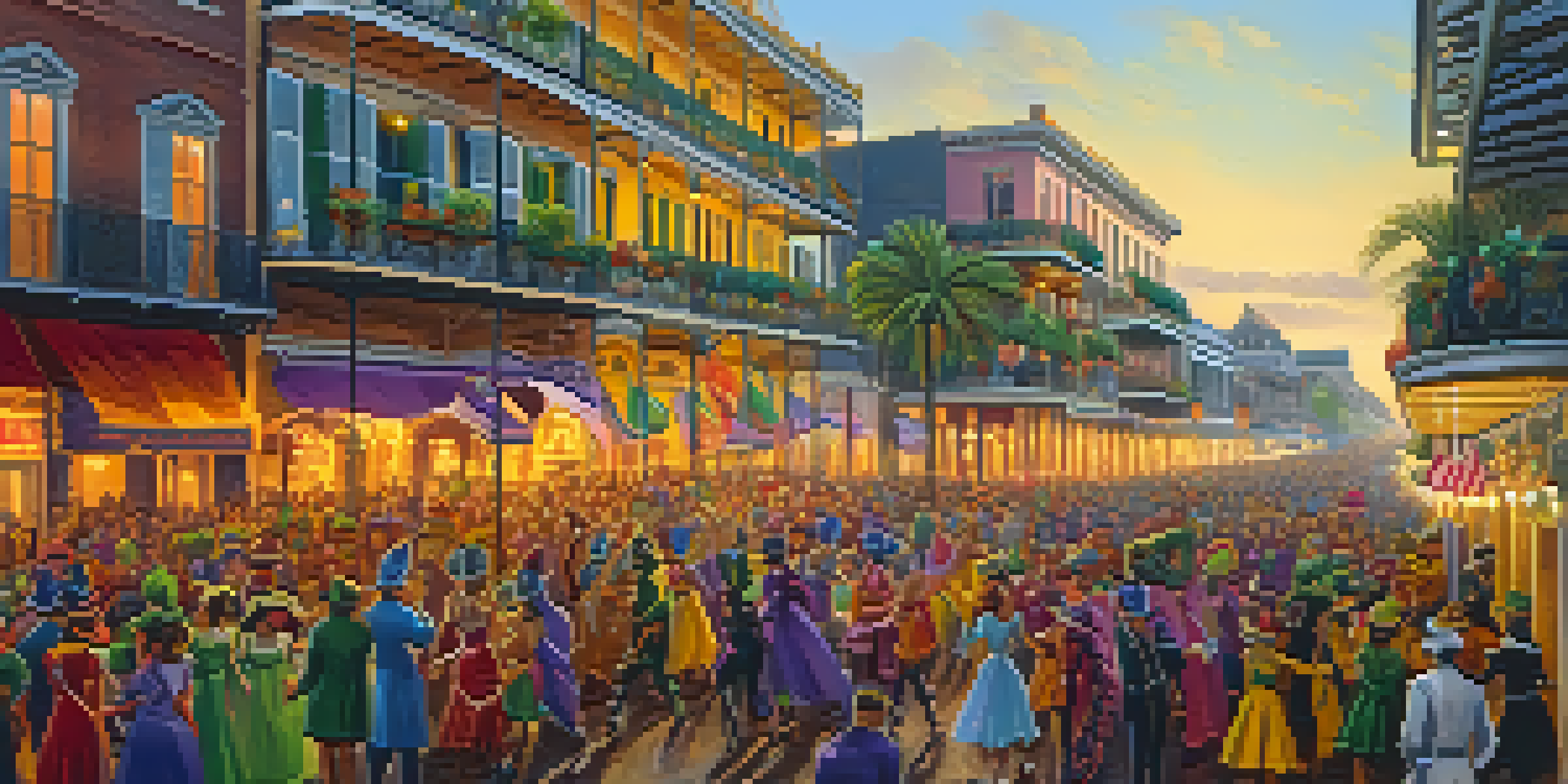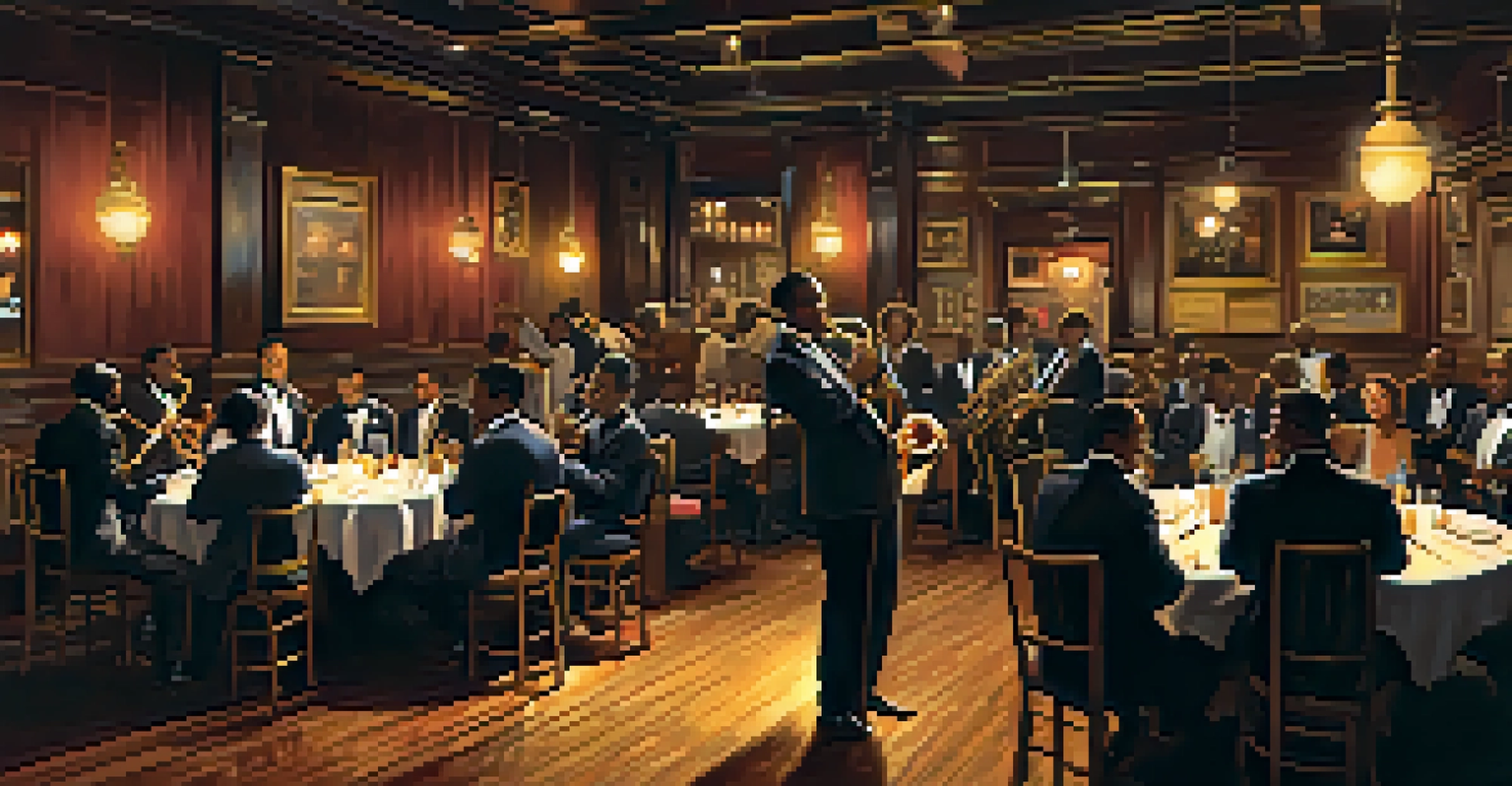Key Historical Events That Shaped New Orleans

The Founding of New Orleans in 1718
The city of New Orleans was founded in 1718 by the French and quickly became a strategic port. Located along the Mississippi River, its unique position allowed for trade and cultural exchange, setting the stage for its diverse character. The choice of location was no accident; the fertile land and access to waterways promised prosperity and growth.
New Orleans is unlike any other place in the world. It is a city that has its own rhythm and soul.
Initially, the city was part of the French colonial empire, and its architecture and culture reflected this influence. Streets were laid out in a grid pattern, much like those in Paris, giving the city a distinctly European flair. This early foundation laid the groundwork for the eclectic mix of cultures that would define New Orleans.
As the city grew, it attracted settlers from various backgrounds, including Spanish, African, and Caribbean influences. This melting pot of cultures would ultimately lead to the unique blend of music, cuisine, and traditions that New Orleans is known for today.
The Impact of the Louisiana Purchase in 1803
In 1803, the United States acquired New Orleans as part of the Louisiana Purchase, a monumental event that doubled the size of the nation. This acquisition not only secured crucial trade routes but also marked a shift in governance, influencing the local culture and demographics. The transition from French to American rule brought new opportunities but also challenges for the existing population.

As American settlers began to arrive, they brought distinct customs and practices, merging them with the existing French and Spanish influences. This blending of cultures enriched the city's identity, leading to the development of unique traditions and a distinctive American Southern culture. The convergence of these influences is still evident in New Orleans today.
New Orleans: A Cultural Melting Pot
The city's founding and diverse influences from French, Spanish, African, and Caribbean cultures have shaped its unique identity.
The Louisiana Purchase also paved the way for westward expansion, impacting the economic landscape of New Orleans. The city became a vital hub for goods moving to and from the western territories, solidifying its importance in American commerce.
The Role of New Orleans in the Civil War
During the Civil War, New Orleans found itself at the center of a pivotal conflict. As a major Southern port city, it was strategically important for both the Union and Confederate forces. In 1862, Union troops captured the city, leading to significant changes in governance and control over resources.
The city is a great place to make a living, but it’s also a great place to make a life.
The occupation of New Orleans by Union forces brought about a complex mix of resistance and adaptation. Many residents were divided in their loyalties, leading to a unique social dynamic. The Union's presence also introduced new economic opportunities for some, while others faced hardships due to the war's toll.
The aftermath of the Civil War brought about Reconstruction, a period that reshaped the city's political and social landscape. The fight for civil rights and the integration of freed slaves into society would lead to lasting changes in New Orleans' culture and community.
The Birth of Jazz in the Early 20th Century
The early 20th century marked a revolutionary period in New Orleans with the birth of jazz music. Emerging from a blend of African, Caribbean, and European musical traditions, jazz became a defining feature of the city's cultural landscape. Pioneering musicians like Louis Armstrong and Jelly Roll Morton played pivotal roles in popularizing this unique sound.
Jazz was not just music; it was a cultural movement that fostered creativity and expression. Nightclubs and dance halls became vibrant spaces where people from diverse backgrounds could come together. This musical revolution also laid the groundwork for future genres, making New Orleans a crucial player in the evolution of American music.
Jazz: The Heartbeat of New Orleans
Emerging in the early 20th century, jazz music became a defining feature of New Orleans, reflecting its rich cultural heritage and creativity.
The influence of jazz extends beyond music; it embodies the spirit of New Orleans itself. The improvisational nature of jazz reflects the city’s resilience and adaptability, qualities that continue to define its character today.
Hurricane Katrina and Its Transformation in 2005
Hurricane Katrina struck New Orleans in August 2005, resulting in one of the most devastating natural disasters in U.S. history. The storm and subsequent flooding displaced thousands of residents and caused extensive damage to infrastructure and homes. This catastrophic event revealed the vulnerabilities of the city and its residents but also sparked a remarkable rebuilding effort.
In the aftermath, New Orleans faced significant challenges, including economic hardships and a declining population. However, the resilience of its people shone through as communities came together to support one another. The recovery process transformed the city's landscape, with new developments and revitalization projects emerging.
Katrina also led to a renewed focus on social justice and equity, as many displaced residents were from marginalized communities. The rebuilding efforts aimed to address some of these inequalities, fostering a spirit of inclusivity that continues to shape New Orleans today.
The Evolution of Mardi Gras Celebrations
Mardi Gras, or Fat Tuesday, has deep roots in New Orleans, with celebrations dating back to the city's early French settlers. This vibrant festival, known for its colorful parades and lively parties, reflects the city's unique cultural blend. Over the years, Mardi Gras has evolved into a significant event that attracts millions of visitors each year.
The traditions associated with Mardi Gras, such as the throwing of beads and the wearing of masks, have become iconic symbols of New Orleans. These customs have their origins in various cultures, including European carnivals and African celebrations, showcasing the city's rich history of cultural exchange. Each year, the festival becomes a canvas for creativity and expression.
Resilience After Hurricane Katrina
The devastation of Hurricane Katrina led to a remarkable rebuilding effort, emphasizing community support and a focus on social justice.
Mardi Gras is more than just a party; it symbolizes the spirit of New Orleans—joyful, resilient, and full of life. As the city continues to celebrate this beloved tradition, it highlights the importance of community and the shared experiences that define its culture.
The Ongoing Influence of Creole and Cajun Cultures
Creole and Cajun cultures play an integral role in shaping the identity of New Orleans. Both cultures have rich histories that blend French, Spanish, African, and Native American influences, contributing to the city's unique character. From language to cuisine, the impact of these cultures is evident throughout New Orleans.
Creole culture, often associated with the city's elite families, is known for its rich culinary traditions, vibrant art, and complex history. Cajun culture, rooted in the rural communities of Louisiana, emphasizes music, storytelling, and hearty food. Together, these cultures showcase the diversity that makes New Orleans stand out.

The influence of Creole and Cajun cultures continues to thrive, as local festivals and culinary experiences celebrate their heritage. From gumbo to zydeco music, these traditions are not just remnants of the past; they are living expressions of the city's vibrant culture.